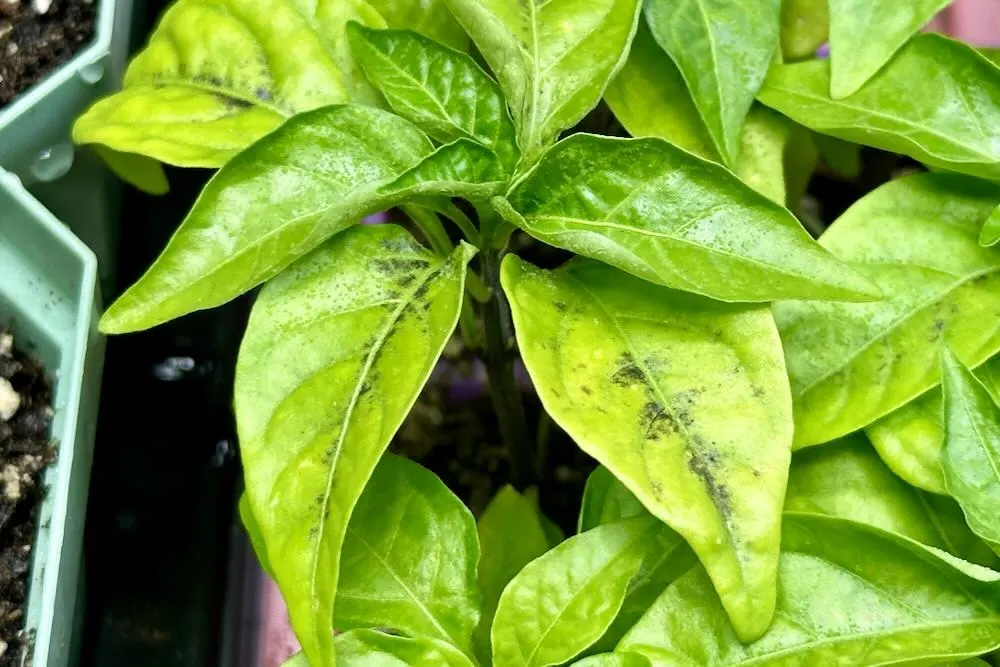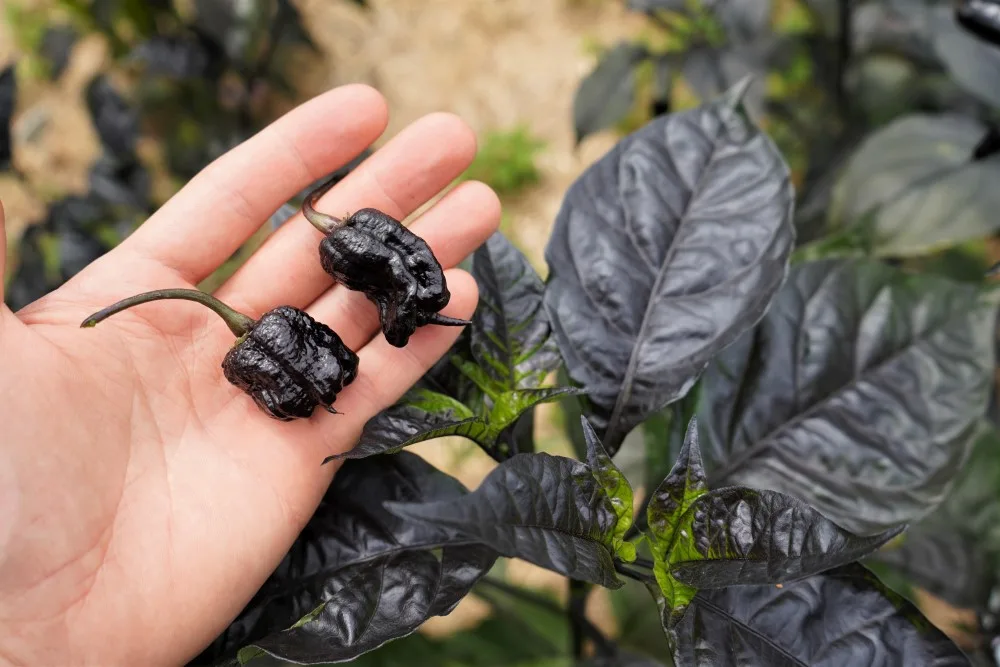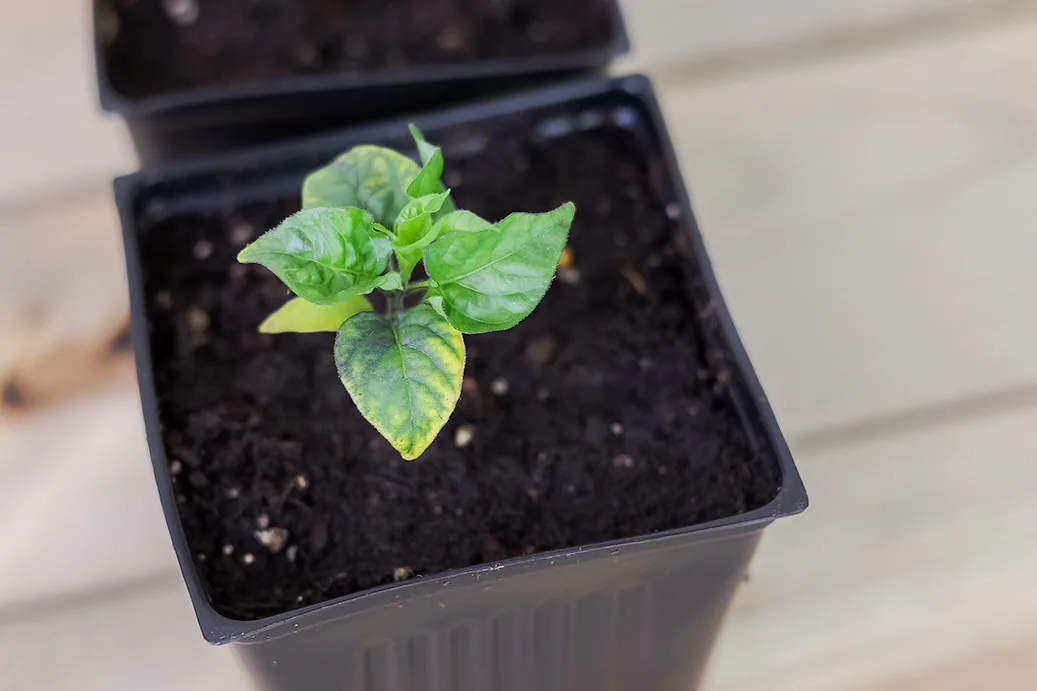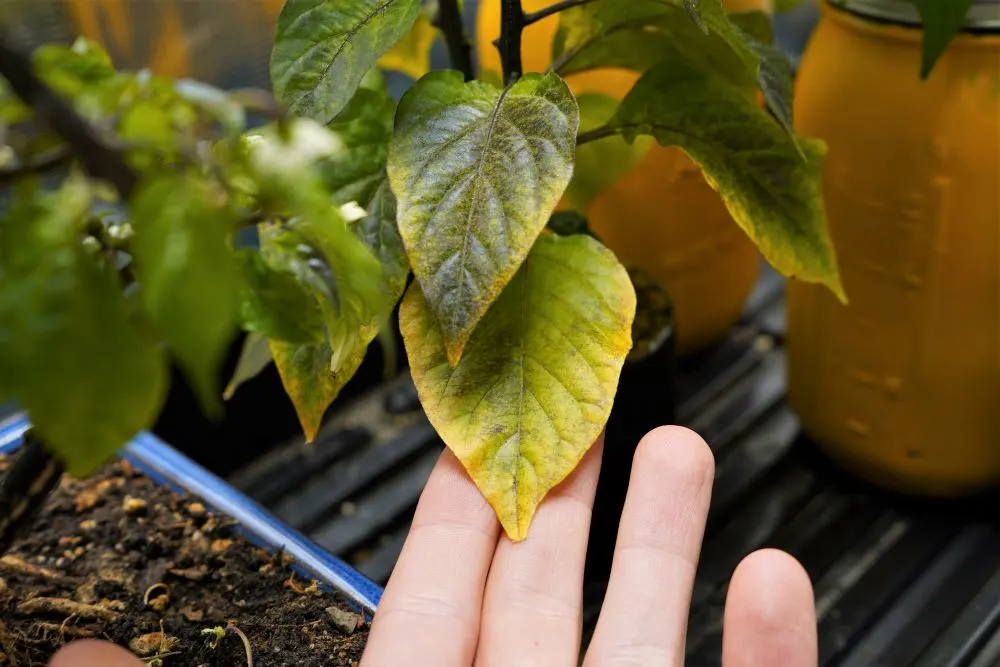Most pepper leaves are supposed to be a rich green color. Yes, there are some varieties that have dark foliage, and even some with white and green streaks, but for the most part, they’re just plain green.
So why do the leaves sometimes turn purple? This is a fairly common problem, especially on indoor pepper seedlings before transplanting outside. However, it can impact fully grown peppers, too.
In this article, I’ll share the top 3 most common reasons for pepper leaves turning purple. For each, I’ll give you simple tips to resolve the issue in no time. Let’s get started!

1. Natural purple pigment (anthocyanins)
Many plants contain anthocyanins. This is a pigment that causes the purple color in blueberries, eggplants, and sweet potatoes. Anthocyanins are activated by light exposure. So, plants grown in shade will have less purple coloration, while plants grown in full sun will be darker purple.
Many pepper varieties also contain anthocyanins. Some are heavy in anthocyanins, while others are less rich in the pigments. This is why you may see purple coloration on some pepper plants, and none on others.

However, even non-purple foliage peppers can show some purple coloration under high light intensity. I have seen purple leaves on banana pepper seedlings, cayenne peppers, and many other green-leaf types, while bell peppers and habaneros stay fully green (in the same conditions!).
Usually, this is nothing to worry about. If the purple color is on the new leaves (the top part of the plant), then this is most likely the cause. You can raise the height of your lights, or lower their intensity, but by and large this will not cause harm to the plants in the long run.
Some peppers will even get purple streaks on the fruits when they are exposed to direct sunlight. This is caused by the same anthocyanin response to light, and is also nothing to worry about.

This is sometimes called a “sun tan” by the pepper growing community. However, the related issue of leaf scorch is a more serious issue that causes white, papery leaves that eventually crumble and die.
So, whether you’re growing a basic banana pepper, or a black pearl pepper, some purple on the leaves may just be normal coloring.
2. Phosphorus deficiency
Phosphorus is one of the 3 primary nutrients used by all plants. It is essential for producing proteins, and for energy transfer in the plant. Without enough, your plants will begin to suffer.
On of the first symptoms of a phosphorus deficiency is purple discoloration on the leaves. This will occur on the lower (older) leaves on the plant, first.

This is because phosphorus is a mobile nutrient, meaning that the plant can move phosphorus from one part of the plant to another as needed. As the supply runs out in the soil, your plant can move phosphorus from the older leaves to the newer growth that is forming at the top.
So, if the purple coloring is on older leaves, your plant may need fertilizer. For potted plants, this is fairly common, especially after the plants have been growing for several weeks in a small amount of soil.
Chances are, if your plants are low in phosphorus, they’ll be low in other essential nutrients as well. So, I’d suggest a feeding of water-soluble all-purpose fertilizer like this. If you want to just add phosphorus, you can use something like super phosphate.
Nutrient lockout
It is possible that your soil has plenty of phosphorus, but a pH imbalance is causing nutrient uptake problems. Phosphorus is most available to plants at a pH of 6.5-7.5. If you are watering your plants with city tap water, it is possible that the pH is out of this range, causing nutrient lockout.
I highly recommend checking your water’s pH at least once. This way, you will learn whether it may be causing nutrient issues within your plants. To test pH, you can use basic test strips or a high-quality pH meter.
If you think you may need to adjust the pH of your water, you can use pH up and down solutions before irrigating your peppers. This can make a pretty drastic difference in the overall vigor of your plants, and the health of the foliage.
3. Cool temperatures
Cold temperatures combined with higher light levels can cause even higher levels of anthocyanins. If your goal is to produce the darkest purple coloration (maybe for selling attractive pepper seedlings), lower temperatures may help.
However, if you’re not happy with the purple leaves, you may need to bump up the temperature in your growing area. Peppers thrive in temperatures between 70-80°F. Anything below about 60°F overnight may lead to slower growth or premature flowering.
Combine cold temperatures with high light intensity, and you’ve got a recipe for purpling leaves. While this won’t technically harm the plants, it may make them look unsightly and cause slower growth. Consider enclosing the plants in a grow tent or smaller space, or using a heater to raise the air temperature to the ideal range.
Will purple pepper leaves turn green again?
Unfortunately, purple foliage will not turn back to green, even after correcting the root cause. However, new foliage that forms on the plants should be green after adjusting the plant’s conditions.
The same is true for other leaf discolorations, such as yellow leaves or white leaves. Always focus on the new leaves at the top of the plant to assess how well the plant is performing.

I hope you can successfully diagnose what is causing your pepper leaves to turn purple. Usually, this symptom is not a major concern, and can be fixed by taking some simple actions!

